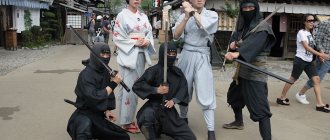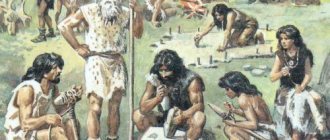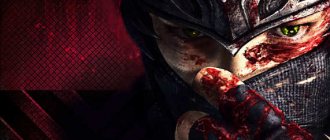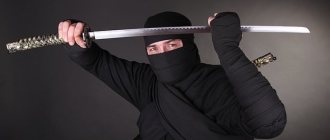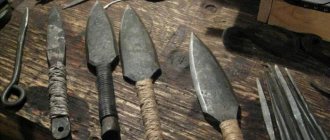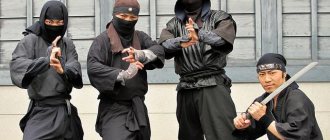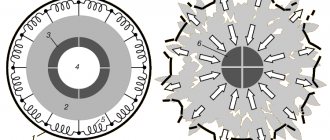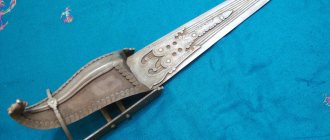The manufacture of each type of weapon always has a specific purpose. For example, offensive, defensive, or how much pain and suffering a weapon will bring to a person. The hero of our article belongs to the latter type - kusari-kama or kusarigama. This weapon was traditional for Japan in the Middle Ages. Kusarigama is considered a Japanese ninja.
Kusarigama could be easily camouflaged. If you remove the chain from the sickle, it can easily become an agricultural tool, so it was not difficult for a professional ninja to get lost in a crowd.
Design
The kusarigama weapon looks like a sickle: the device is characterized by a handle length reaching 60 cm; a sickle-kama (in Japanese) is attached to the handle, with a blade 20 cm long, sharpened and concave inward at the end with a point; On the side of the sickle butt, a chain-kusari up to two meters long is fixed, sometimes more, sometimes less, with a shock load-fundo.
The chain can also be attached to the opposite side of the handle. These weapons were modified depending on the schools involved in their use in battle. Kusarigama is one of the most complex types of Japanese weapons.
Karate
Karate as a martial art developed on the islands of the Ryukyus archipelago, in the territory of modern Okinawa. Karate has its roots in the ancient martial techniques of the Ryukyu Islands, which were influenced by Chinese martial arts. In karate, the practitioner's skill is marked by the corresponding color of the belt. The black belt signifies the highest level of skill and training of its wearer. The philosophical foundations of karate are to achieve a true, strong, unshakable spirit, to improve one’s personality.
On video – certification for a black belt in Russia:
https://youtube.com/watch?v=g1JwEpIa1vs
The video shows the performance of the Japanese team at the 21st World Karate Championships:
Types of kusarigama
Experts distinguish two types of kusarigama: farm and military. The first sickle designs had short blades that resembled curved bird beaks. The blade designs of the latter were more reminiscent of small swords. For both, the attachments to the handles were made of hardwood.
Farmer kusarigamas do not have the same throw range as military ones. In addition, they are not as effective in close combat. These types of combined weapons are bilateral.
The ninja's auxiliary equipment amazed with its ingenuity
- Kaginawa - “cat” from the ninja arsenal
- Ashiko, put on legs to climb walls
It's funny that movie ninjas in their grotesque arsenal are not so far from real ones. A shinobi's bag could contain makibishi - spikes made of nails or iron plates that were thrown to the ground to injure the enemy's legs. A pipe with coals was useful for arson, where they retained their heat. By the way, in an ambush such a pipe could be used to warm your hands (a most useful thing!).
In addition, the ninja could carry a metsubushi on a mission - a container for a mixture of pepper and ash, which was sprayed into the enemy’s eyes. The container could be a small bag, a bamboo tube, or even an egg.
Metsubushi box.
The scabbard could have been a kind of metsubushi
Ninjas, as we remember, wore shortened swords, but the sheath, so as not to attract attention, was usually made of normal length. A mixture that hurts the eyes was poured onto the bottom of such sheaths.
As planned, the shinobi, sharply pulling out his sword, at the same time sprayed it towards the enemy. We will do without spoilers, but note that in Sekiro the enemies have learned new villainies in this area as well - we have never seen anything like this in a From Software game.
Kunai is a tool for hollowing out steps in walls.
The main character of Sekiro: Shadows Die Twice uses a grapnel with a rope to quickly fly up onto rooftops and cliffs. Real ninjas also knew a similar device - kaginawa. However, more often shinobi preferred a more “proletarian” set: drills, saws and the so-called kunai - a sharpened construction trowel. All this was needed to hollow out steps in the walls. In other words, the typical shinobi did not jump onto enemy walls like a cat, he bit into them like a beetle. Such tools did not arouse suspicion among the authorities, and the kunai was also used as an additional weapon.
Varieties
Japanese fighters came up with a huge number of varieties of kusarigama. So, in some variations the fundo was replaced with rather specific attributes:
- Skeins of burning fabrics;
- Explosives in special containers;
- Live poisonous snakes;
- Torches and stuff.
When, instead of traditional weights, kusarigamas were equipped with bags of explosive mixtures, this type of weapon was called “bakuhatsu-gama,” which translated as “explosive sickle.” The most important highlight of this ingenious device was complete surprise for the enemy upon direct contact with him, and especially from the impact of the original “explosive package”.
As a result of the weapon's contact with the enemy, a thunderous explosion was heard, which completely led to the enemy's disorientation for some time. After such contact, the enemy faced the attacker in a more vulnerable position for subsequent attacks. This type of kusarigam was especially effective against a group of enemies.
The types of kusarigama changed depending on which schools were involved in their development and combat use. Experts call the Isshin-ryu school one of the most successful schools in the field of kusarigama-jutsu. Some of them suggest that it was formed by Nen Ami Jiong in the 14th or 15th centuries, while others believe that Tang Issin, but later.
Actually, the kusarigama of this school differ among others in their design. They consisted of extremely long chains and straight blades, sharpened on both sides. And this despite the fact that, as a rule, they were sharpened only from the inner parts of the sickles. In addition, the kusarigama of the Isshin-ryu school had metal guards to protect their hands.
There was also the so-called kaen-kusarigama. Its distinctive feature from standard samples of similar weapons was that its sinker was wrapped in a piece of flaming material. As a result of this improvement, attackers achieved an incredible demoralizing effect on their enemies.
The most sophisticated and amazing component of this weapon was the use of a live poisonous snake. Mamushi were mainly used for these purposes. This is a type of Japanese cottonmouth. With the help of mamushi-gam, or snake sickles, the enemy was distracted. This provided the attackers with precious fractions of a second to deliver precise blows decisive for the outcome of the battle.
It is interesting that the warriors themselves accepted universal condemnation of these bladed weapons as not entirely honest.
Kalaripayattu in a hypothetical street fight
The most burning question is: what about the sports and street component of Kalaripayattu? Yes, in general, nothing. In any case, there are no competitions or degrees of mastery in this art, and, in general, initially, in the 6th century, this was normal, because the life of a warrior itself provided constant practice. Skills were tempered in skirmishes with enemies, wild animals and bandits.
However, how high combat prowess is maintained now, in our peacetime, is an open question. Moreover, it’s somehow not customary to walk down the street with a sword and shield, and law enforcement officers won’t be too happy if someone chops up a couple of street corner drunks into cabbage. As for technology, the northern school with its enchanting jumps is not very suitable for our icy latitudes - it is too easy to sit on your butt in the middle of a battle.
The question of full-contact hand-to-hand sparring generally remains open. Maybe they are held in groups, but on the Internet you can only find this kind of misunderstanding, and it is not clear which of these people is engaged in boxing and which is an adherent of Kalaripayattu.
And the current masters themselves say that Kalaripayattu is not a sports or applied discipline, but a way of spiritual and physical self-improvement. So in modern realities, the Indian fighting style is for those who want to plunge into the exotic, get to know themselves and train the body. For self-defense and athletic achievements, you will have to do something else.
Application technique
One of the main advantages of kusarigama was its versatility. It can be said that this advantage compensated for the high complexity of using the kusarigama. These weapons could be used to inflict cutting, piercing, and crushing blows on the enemy. The art of wielding this war sickle is called kusarigamajutsu.
Sometimes a heavy kusarigama was used as a throwing weapon: you can throw a sickle at an enemy, and if unsuccessful, return it with a chain. The sickle was effective in close combat, and at long range the enemy could be killed with a weight or entangled in a chain, and then finished off with the sickle. Japanese chronicles report that the kusarigama was often used as a throwing weapon in the defense of fortresses.
Kusarigama is considered one of the most complex types of Japanese bladed weapons. In order to master it, a warrior needed thousands of hours of daily training. This factor seriously limited the spread of kusarigama.
Particularly difficult was the technique of wrapping a chain around the enemy or his weapon. In order to master it perfectly, a fighter needed to perfectly develop his eye and learn to subtly sense the moment the enemy’s attack began. The correct unwinding of the chain was crucial for a successful throw; in case of an error, the fighter himself could become entangled in his own weapon. Another feature of the kusarigama was that in order to effectively use the chain, the fighter needed significant free space.
There is a description of an epic duel between the skilled swordsman Araki Mataemon and Yamada Shinryukan, who masterfully wielded the kusarigama. Araki lured his opponent into a bamboo grove, where Shinryukan could not fully use his deadly weapon.
As mentioned above, it is not known who exactly invented the kusarigama, but “agricultural” motives are clearly visible in this weapon. Ninjas are often credited for its invention, which seems very plausible. After all, another undoubted advantage of kusarigama is the ease of its disguise. Having unhooked the load from the sickle, it is very easy to pass it off as ordinary agricultural equipment and get lost in the crowd of peaceful peasants. And making such a weapon was as easy as shelling pears.
Another fact that confirms the “spy” origin of the kusarigama is the time of appearance of this weapon. The Muromachi or Sengoku period was also called the time of the Warring States. Complete confusion and chaos reigned in the country, everyone was at war with everyone, secret murders of military leaders were very often practiced. During this period, ninjas or shinobi had especially a lot of work. Unlike a sword, which is quite difficult to hide, the kusarigama is great for carrying out secret missions.
Although, samurai also used kusarigama. One of the most famous schools of using these weapons - Isshin-ryu - was founded by a samurai named Nen Ami Jion. According to legend, this famous warrior saw in a dream a deity with a sickle in one hand and a sinker in the other. The kusarigama used in Isshin-ryu has an atypically long chain (more than 3.5 meters) and a double-edged sickle.
Ability to use kusarigama
To achieve mastery of this weapon, it takes months, or even years. It is advisable to first learn how to practice the technique of wrapping an enemy’s weapon with kusari. To do this, you need to subtly sense the enemy’s attack, try to get close enough to him to have time to deliver a damaging blow.
In this case, it is necessary to correctly estimate the distance and spin, because if the calculation is incorrect, the owner risks striking himself. A fighter with a kusarigama will have significant advantages in battle due to the diverse possibilities of using this weapon.
Some martial arts practitioners classify kusarigama as a specific weapon, while others consider its use unacceptable due to the impossibility of defending against it. Maybe the reason was that it takes a lot of time to master it and this limits its popularity.
In addition to the fact that there are difficulties in mastering the kusarigama fighting technique, there is another drawback that prevents you from using this weapon effectively, and, accordingly, prevents you from defeating the enemy.
This drawback is the space required to unwind the chain, which is needed to capture the enemy with it, and then attack with a sickle from the flank or hit from the rear. This flaw was pointed out by the famous swordsman Araki Mataemon, who fought with the kusarigama combat master Yamada Shinryukan. Araki lured the enemy into the grove, where the small space prevented the second fighter from using this weapon at full power. In the end, the fencer won.
Use of weapons
Using the kusarigama control technique allowed:
- strike the enemy with a fundo weight;
- entangle with a chain;
- then attack with the sickle.
They also carried out throwing actions with the sickle itself and returned it using a chain. It was often necessary to use kusarigama in the defense of fortresses. Learning to use it is a rather long and complex process, but the good combat versatility of the weapon compensates for the time spent. They can be applied:
- Cutting.
- Stabbing.
- Crushing.
- Throwing actions.
There are even arts for fighting using this device:
- kusarigamajutsu;
- kobudo;
- kukishinden-ryu;
- happo-hiken-ju.
For example, Kobudo is a traditional Okinawan martial art of bladed weapons. In the Kuki family of small feudal lords, the knowledge of Kukishinden-ryu and Happo-hiken-ju battles was passed down from generation to generation. The school's technique belongs to the samurai style of Katori Shinto-ryu, Kashima Shinto-ryu.
The martial art of Kukishinden-ryu is considered unrelated to ninjas, since the fighting technique uses heavy samurai armor - eroi.
There was a period in Japan when provinces fought with each other and then warriors used more sophisticated loads for kusarigama. For example, stilettos in the form of snakes were used with mamushigama weapons, and sometimes live reptiles were attached to the device; they attacked the enemy with their poison.
There were many variations of this weapon, ranging from small in size to impressive.
They are easy to disassemble and transport, so each owner created their own models. So, devices were attached to the knob that:
- Exploded.
- They were burning.
- Or blinded.
There were also very large models - these are o-gama, and in kaen-kusarigama the load was wrapped in cloth, which was then set on fire or replaced with a small torch.
Origin of Kalaripayattu
The word Kalaripayattu consists of two parts. “Kalari”, according to one version, is a “sacred place”, “temple”, according to another - “a training hall”, “a gymnasium”. "Payattu" - "fight", "battle". So it turns out that Kalaripayattu is literally “a fight in a sacred place” or “a battle in a gymnasium.”
In general, both meanings are quite suitable for the modern version of this art. Classes take place in training halls, which are also temples with altars on which sacrifices are made to Hindu deities. Traditional kalari halls are small in size, deeply sunk into the ground, with earthen floors and wooden walls. Classes there are held in the morning to avoid the stifling Indian heat.
The first reliable mentions of Kalaripayattu date back to the 6th-7th centuries AD, when it was finally formed during the period of numerous wars between the Chora and Chola dynasties. However, the very term “kalari” for a battle site is mentioned in Sangam literature dating back to the 3rd century BC, which was 2,300 years ago. It also mentions the use of various weapons by warriors. Therefore, the most optimistic lovers of Kalaripayattu consider these recordings to be the first mentions of their art.
Additionally, according to legend, the creator of Chan Buddhism (now better known as Zen) named Bodhidharma was a master of Kalaripayattu and taught it to his followers. If this legend is to be believed, then the famous martial art of Shaolin directly comes from Kalaripayattu.
What was achieved with the help of kusarigama
Well-trained warriors, if they had competent handling of kusarigama, were allowed to combine close and ranged combat techniques. Defending against such unpredictable bidirectional weapons has proven to be a difficult task in practice. Warriors who mastered the kusarigama could successfully fight the most serious opponents.
Using the enemy's sinker:
- Disarmed;
- Stunned;
- Injured;
- Disoriented;
- Immobilized, etc.
They repelled blows with sickles and also finished off the enemy. Sometimes the sickle was thrown and then returned using a chain. The main disadvantage of this weapon was the need for a large open space for the heavy chain to swing freely.
Yawara
It is a wooden cylinder, 10 to 15 centimeters in length and 3 centimeters in diameter. Yawara is wrapped around the fingers, and its ends protrude on both sides of the fist. Thus, this rather simple brass knuckles serves to weight and enhance the effect of the blow. But the purpose of the yawara is to apply poking blows with the ends of the ends, mainly in the centers of nerve bundles, tendons and ligaments.
The very appearance of yawara in Japanese culture is explained by two versions. According to one of them, the Japanese brass knuckles are like a symbol of faith, which was an attribute of Buddhist monks - vijra. This is a small shaft, reminiscent of an image of lightning, which the monks used not only for ritual purposes, but also as a weapon, since they needed to have it. The second version is the most plausible. An ordinary pestle, which was used for pounding cereals or seasonings in a mortar, became the prototype of the yawara.
The black shinobi outfit is a myth born of theater
The classic jet-black shinobi costume is a myth created by the Japanese themselves, and it is based on a curious mistake. The fact is that in the theater, actors dressed in black and moving against a black background simply portrayed the hidden forces of nature and even ghosts. So by “killing” the hero on stage, they symbolically showed that the blow came out of nowhere, and the ninja remained elusive. Over time, this stereotype became entrenched, and many began to believe that a black suit was the professional clothing of a shinobi.
The ninjas themselves preferred to wear dark gray, dark brown or dark blue during sabotage - black, oddly enough, stands out too much in the twilight and is not so good for camouflage. In this sense, the hero of Sekiro is quite historical: he is dressed in loose clothing, comfortable for a warrior and discreet.
Naginata
Naginata has been known in Japan since at least the 11th century. Then this weapon meant a long blade from 0.6 to 2.0 m long, mounted on a handle 1.2-1.5 m long. In the upper third, the blade expanded slightly and bent, but the handle itself had no curvature at all or was barely outlined. At that time, they worked with naginata using wide movements, holding one hand almost at the very blade. The naginata shaft had an oval cross-section, and the blade with one-sided sharpening, like the blade of the Japanese yari spear, was usually worn in a sheath or sheath.
Later, by the 14th-15th centuries, the naginata blade was somewhat shortened and acquired its modern shape. Nowadays, the classic naginata has a shaft 180 cm long, onto which a blade 30-70 cm long is attached (60 cm is considered standard). The blade is separated from the shaft by a ring-shaped guard, and sometimes also by metal crossbars - straight or curved upward. Such crossbars (Japanese hadome) were also used on spears to parry enemy blows. The blade of a naginata resembles the blade of an ordinary samurai sword; sometimes this is what was mounted on such a shaft, but usually the blade of a naginata is heavier and more curved.
The first ninja was a prince in a maid costume
Legends say that the first shinobi was the 2nd century crown prince Yamato Takeru, the son of Emperor Keiku. In 97, he killed the leader and hero of the barbarian Kumaso people in cold blood, disguised as a maid and sneaking into the enemy's chambers. Having lost their leader, the Kumaso were easily subdued by Yamato's troops.
Ninjas are descended from warrior monks. It is impossible to say exactly how ninjas appeared, and from what point in the history of Japanese spies should be called this word. However, the most common (and most interesting) version says that shinobi came from among the hermit monks of Yamabushi. They understood Buddhism in a very unique way, and preferred military training and drill to meditation.
The Yamabushi did not shy away not only from battles, but also from espionage. Living in the mountains, they learned to blend in and survive in the wild, making them the best spies in the country. Aristocrats and even emperors did not fail to take advantage of this, whom the monks “helped” for generous donations to the temple.
Most often, shinobi disguised themselves as monks and lumberjacks
Monks were a very convenient role for disguise. They walked freely around the country, often carried weapons with them, and had writing materials with them (and ninjas often found them useful for sketching terrain and copying secret documents). Most suitable were the monks of the komuso school, who wore baskets on their heads to cover their faces. Just perfect for a spy and assassin.
Komuso monks.
Another common role is “shinobi-monomi”, that is, shinobi lumberjacks. Firstly, they carried axes with them, and no one paid attention to it. Secondly, they also moved relatively freely, and the patrols did not see anything special about the woodcutter wandering through the forest. However, women's roles were different. Female shinobi were called “kunoichi” and in their disguise they relied more on social skills and hid not away from people, but in the thick of the crowd. A geisha, a prostitute, an acrobat of a traveling theater, a seductive peasant woman are no less successful roles for a murderer than a monk or a lumberjack.
Killing is only a small part of a shinobi's job
In fact, they are more spies and saboteurs than death machines. Typical tasks performed by a ninja: a spy and thief of secret documents (kancho), a scout and spy (teisatsu), a surprise attacker (kishu), and a provocateur agitating the crowd (konran).
Ninjas not only killed, but also protected. But is the hero of Sekiro, the One-Armed Wolf, so far from the truth? At first glance, yes: he devoted his life to selflessly protecting a young lord who is captured - more like the way of a samurai than a shinobi. However, there are examples in history of how ninjas were hired as bodyguards, and they did an excellent job. Ieyasu Tokugawa himself, the founder of the great shogunate, did not hesitate to hire shinobi to protect his own life. The legendary ninja Hattori Hanzo, who ruled the Iga clan, generally became a vassal and favorite of the shogun.
Ninjas are the true children of chaos
Shinobi as a unique class took shape in the 10th century during the peaceful Heian era (it even means “peace”). But their heyday came during the “Era of the Warring States,” Sengoku Jidai. During the great civil war, the warring princes needed the services of the ninja more than ever. The two most important clans of shinobi, Iga and Koga, were generally unashamedly located in the vicinity of the capital, Kyoto - closer to their clients.
The reason for the rise of the ninja during the Sengoku period was the hypocrisy of the samurai. On the one hand, they extolled military honor, and on the other, they were in dire need of saboteurs and spies, whose services provided an undeniable advantage in internecine wars. The compromise was hiring ninjas.
A perfect example of how this worked: In 1558, Prince Rokkaku Yoshikata hired a team of shinobi to set fire to Sawayama Castle. They stole a lantern with the enemy's coat of arms, which was used as a pass into the castle, which allowed them to freely enter inside and start arson. The irony is that later the besieged themselves hired the same ninjas to set fire to Yoshikata - nothing personal, just business.

